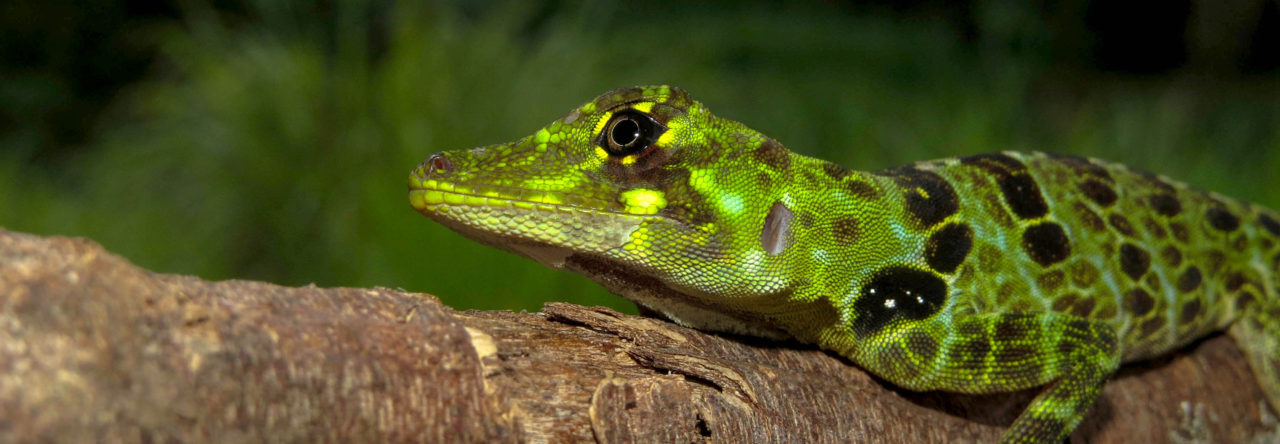
Anolis shrevei, a species inhabiting extreme cold environments on Hispaniola.
Caribbean anoles are widely recognized as a key example of “adaptive radiation,” or the diversification of a group of organisms into different ecological niches*. Anoles in the Greater Antilles (Cuba, Hispaniola, Jamaica, and Puerto Rico) diversified into multiple types of habitat specialists, or “ecomorphs,” so-named for the portion of the structural habitat that they most often occupy. For example, “twig” anoles are found on the distal ends of branches. They have relatively short limbs (and, often, prehensile tails) for navigating their spindly habitat. The ecomorphs have evolved a myriad of morphological features suited to their microhabitat use. But diversification into different structural niches comprises only one dimension of their radiation across the Caribbean. Anoles have also diverged into distinct climatic habitats in the Greater Antilles, such as Anolis shrevei (pictured above), a montane species found at high elevation in the Cordillera Central mountain chain of the Dominican Republic. Some anoles are restricted to desert scrub habitats, others to cloud forests, and others to warm lowland environments. The list goes on!
But how does climatic evolution fit into the bigger picture of the Anolis adaptive radiation across the Caribbean? In a previous study, Mahler et al. (2010) suggested that “ecological opportunity” (roughly, the lack of competitors for ecological niche space) influences rates of morphological diversification into different portions of the structural habitat. In a study just published in Global Ecology and Biogeography, Adam Algar (University of Nottingham) and Luke Mahler (University of Toronto) sought to test the idea that ecological opportunity also influences rates of climatic niche evolution in Caribbean anoles. Although they are tropical, several of the Caribbean islands possess considerable elevational variation , which has created substantial thermal variation and the potential for climatic niche evolution in anoles (See Figure 1 below).

Portion of Figure 1 from Algar and Mahler (in press) showing temperature variation in the Greater Antilles (a) and the Lesser Antilles (b).
Algar and Mahler first quantified two temperature axes (mean temperature and temperature seasonality of species’ localities) of the climate niche for 130 Anolis species on each of the islands in the Greater Antilles, as well as from the northern and southern Lesser Antilles (i.e., the series of small, volcanic islands that dot the eastern Caribbean Sea). The first temperature axis (PC 1) correlated with thermal minima and maxima and the second temperature axis (PC 2) correlated with temperature seasonality.

Figure 2 from Algar and Mahler showing how rates of thermal PC 1 relates to climate heterogeneity (a), and geographic area (b). (c) shows how rates of thermal PC 1 evolution correlate with climatic heterogeneity after correcting for geographic area. Relationships depicted in (b) and (c) are statistically significant.
They showed that rates of niche evolution for thermal PC 1 was significantly higher in geographically larger regions (Fig. 2b). Thermal PC 1 was, however, unrelated to climatic heterogeneity (Fig. 2a). But, when the residuals of the relationship between thermal PC 1 and geographic area were regressed against climatic heterogeneity, they did recover a significant positive relationship (Fig. 2c), indicating that, over a given area, thermal niche evolution is faster in regions with greater climatic heterogeneity. They conducted the same analyses for thermal PC 2 (temperature seasonality) and, as with PC 1, found no relationship between evolutionary rate and climate heterogeneity and a positive relationship with area. However, in contrast to their results with PC 1, even after controlling for geographic area, they did not recover a significant relationship between evolutionary rate and climatic heterogeneity.
To determine whether the relationships between evolutionary rate and island area could be due to the higher species numbers found on larger islands, they regressed the evolutionary rate against species number. They did find a strong relationship between species number and evolutionary rate. However, given that island area and species number are highly correlated, this result was not unexpected. Thus, they were unable to fully disentangle how island area and species might interact to influence rates of the climatic niche evolution.
In short, Algar and Mahler found that island area greatly influenced the rate of climatic niche evolution. It has long been recognized that island area is a major determinant of species richness and species diversification on islands – on islands above a certain threshold size, in situ speciation can occur. In this study, Algar and Mahler add climate niche radiation to the list – on islands above a certain size, climatic niches can diverge considerably. But how, specifically, does island area contribute to rates of climatic niche evolution? The authors suggest that larger islands allow more speciation along elevational gradients, such as mountains, which can result in climatic specialization (either during the process of speciation or post-speciation). On small islands, they argue, high gene flow may swamp out the effects of climatic divergence even where climatic thermal heterogeneity exists and, when such specialization does occur, those species may be susceptible to higher extinction rates (due to their smaller geographic ranges). In short, climatic niche evolution presents an equally important (though relatively understudied) aspect of the Anolis adaptive radiation in the Caribeean.
—————————
*Scientists differ in their definition of adaptive radiation, though most can agree with the idea that it involves adaptive diversification. Here I follow the definition of Losos and Mahler (2010).
Works Cited
Algar, A. C., and D. L. Mahler. In press. Area, climate heterogeneity, and the response of climate niches to ecological opportunity in island radiations of Anolis lizards. Global Ecology and Biogeography.
Losos, J. B., and D. L. Mahler. 2010. Adaptive radiation: the interaction of ecological opportunity, adaptation, and speciation. Pp. 381-420 in M. A. Bell, D. J. Futuyma, W. F. Eanes, and J. S. Levinton, Eds. Evolution Since Darwin: The First 150 Years. Sinauer Associates, Sunderland, MA.
Mahler, D. L., L. J. Revell, R. E. Glor, and J. B. Losos. 2010. Ecological opportunity and the rate of morphological evolution in the diversification of Greater Antillean anoles. Evolution 64:2731-2745.
















